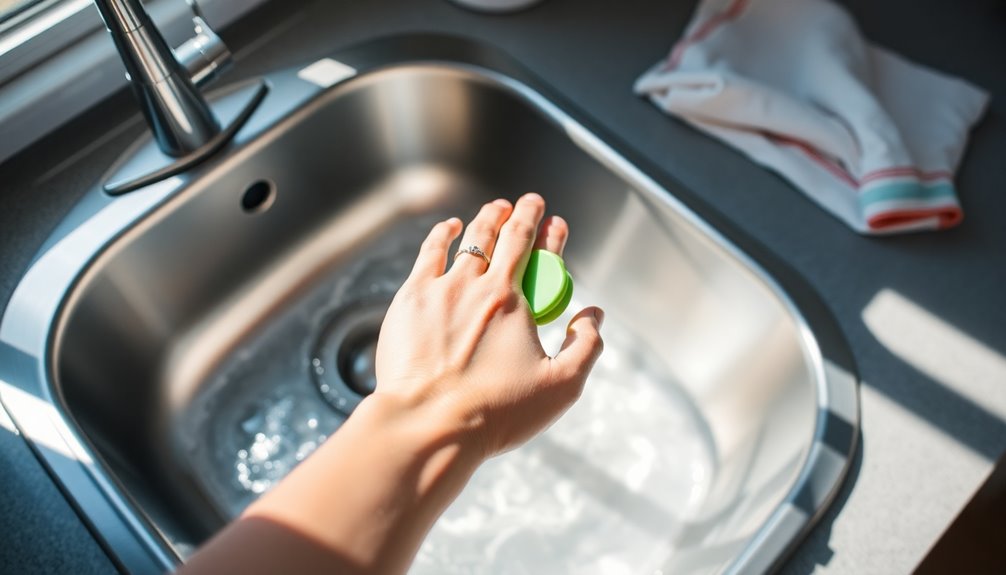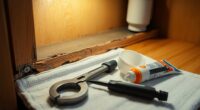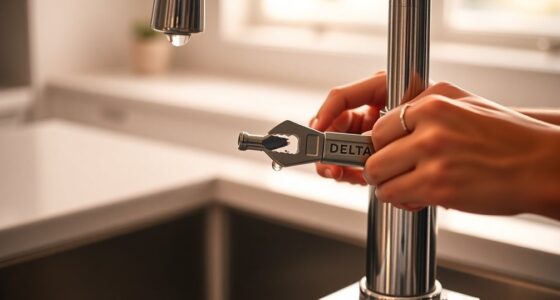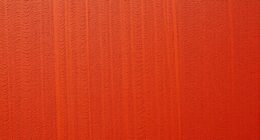You can easily plug your kitchen sink without a stopper by using common household items. Try wrapping an old washcloth or sock in a plastic bag and inserting it tightly into the drain. If you need a quicker fix, a ziplock bag tied into a knot works well too. Just fill the sink with water and check for leaks. If you're looking for more creative solutions and tips, there're plenty of options to explore further.
Key Takeaways
- Use an old washcloth or sock wrapped in a watertight plastic bag as a makeshift sink plug.
- Tie a plastic bag into a knot and place it in the drain for a temporary seal.
- A yogurt lid can serve as a sturdy, reusable sink plug for various drain sizes.
- Fill the sink with water and apply a toilet plunger to create a vacuum effect for dislodging stuck stoppers.
- Regularly clean and inspect your DIY plug to maintain its effectiveness and prevent leaks.
Understanding the Need for a Sink Plug
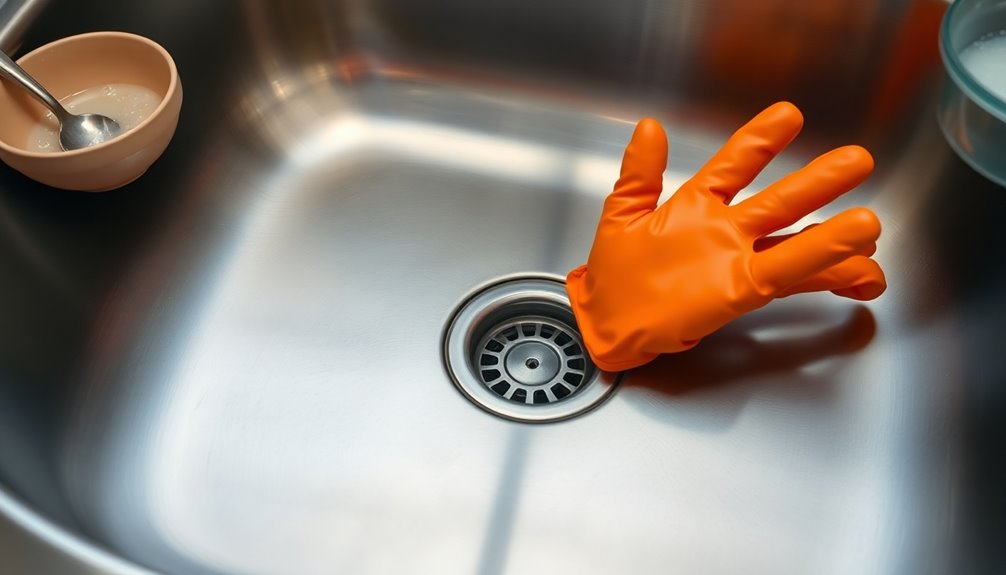
When you need to wash dishes, soak clothes, or even bathe, a sink plug is essential for keeping water from draining away. Without it, water can easily escape, wasting resources and interrupting your tasks.
Imagine trying to wash dishes in a sink that won't hold water—it's frustrating, right? You might find yourself rushing to find a solution during busy moments in the kitchen.
Understanding how to temporarily seal a sink drain can save you until you get a proper plug. Plus, exploring DIY options not only offers immediate fixes but also promotes sustainability by reusing items you already have.
Essential Materials for a DIY Plug

Finding a quick solution to plug your sink can be simple with the right materials on hand. You can use common household items like an old washcloth or sock as your main component.
To guarantee it's watertight and effective, wrap the washcloth or sock inside a plastic bag. This combination creates a reusable makeshift plug that works similarly to a traditional stopper. You can adjust the size of your materials, using larger or smaller socks and washcloths to fit different drain sizes.
Not only does this method provide an immediate fix, but it also promotes sustainability by reusing items you already have, ultimately reducing household waste.
Get creative and make your DIY sink plug today!
Step-by-Step Guide to Creating a Makeshift Drain Plug
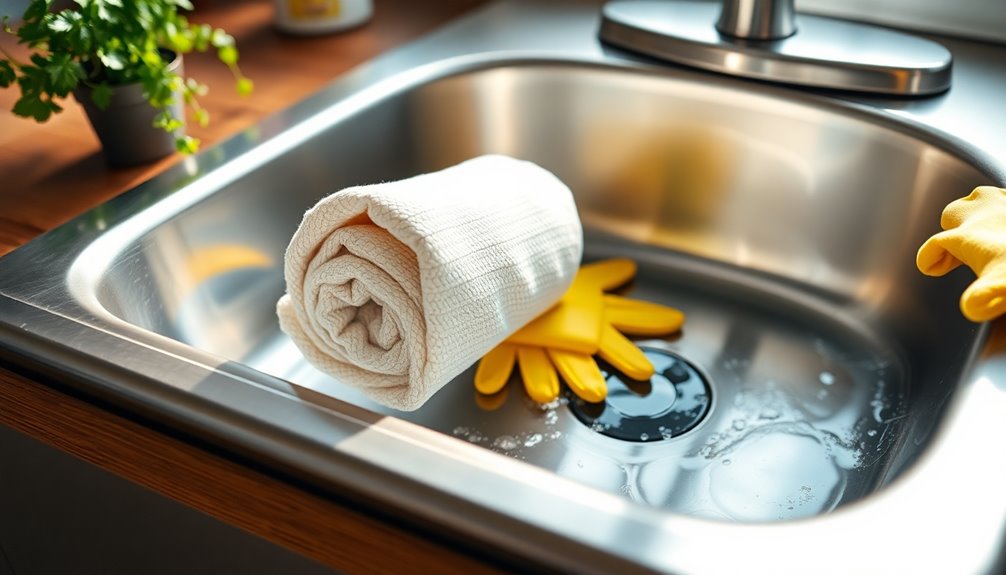
To create your makeshift drain plug, gather a washcloth or old sock, along with a plastic bag.
Once you've wrapped the cloth or sock in the bag, test it to make sure it fits snugly in the drain.
This simple method not only works effectively but is also a sustainable solution for your kitchen sink.
Gather Necessary Materials
Creating a makeshift drain plug is simple and requires just a few common household items. To get started, gather the following materials:
- A washcloth or an old sock
- A watertight plastic bag, free from holes
- Scissors (if needed for adjusting the size)
- A knot or tie for securing the bag
Once you have these items, place the washcloth or sock inside the plastic bag, wrapping it securely like a gift.
Make sure to knot the bag tightly to maintain its shape. The wrapped item should fit snugly in the drain opening to effectively block water passage.
This DIY solution is reusable and provides a quick fix until you can get a proper drain plug.
Test Plug Effectiveness
How can you guarantee your makeshift drain plug works effectively? Start by creating your plug using a washcloth or an old sock wrapped in a waterproof plastic bag. Make sure the bag is tightly knotted to maintain its shape. Next, insert the wrapped item into the drain opening.
To confirm its effectiveness, check the snugness and ability to block water flow. Here's a quick checklist to help you evaluate the plug:
| Test Criteria | Status |
|---|---|
| Fits snugly in the drain | Yes / No |
| No leaks observed | Yes / No |
| Holds water effectively | Yes / No |
| Condition stable | Yes / No |
Monitor your DIY plug during use, and be ready to adjust or replace it as needed.
Testing Your DIY Sink Plug for Effectiveness

Once you've made your DIY sink plug, testing its effectiveness is essential to confirm it properly seals the drain. Here's how you can do that:
- Fill the Sink: Pour water into the sink and place the plug securely in the drain.
- Observe for Leaks: Check for any water leaking around the edges of the plug.
- Apply Pressure: While the water's running, press down on the plug to confirm it maintains its seal.
- Monitor Over Time: After testing, keep an eye on the plug's condition, as repeated use may require adjustments or replacements.
If you notice small leakages, consider modifying the plug for a better fit. This will confirm your DIY solution works effectively every time!
Alternative Household Items for Blocking Drains

When you find yourself without a traditional sink stopper, numerous household items can serve as effective alternatives for blocking your kitchen drain. An old washcloth or a sock can easily be repurposed to create a makeshift plug.
If you have a plastic lid from a yogurt container, trim it to fit snugly over the drain. For a watertight seal, combine a thick plastic bag with a soft item like a washcloth.
An air-filled ziplock bag can also work, using air pressure to keep it in place. In emergencies, a rolled-up towel can absorb water and act as a temporary barrier.
These simple solutions can keep your sink functional until you find a proper stopper.
Tips for Maintaining Your Makeshift Plug
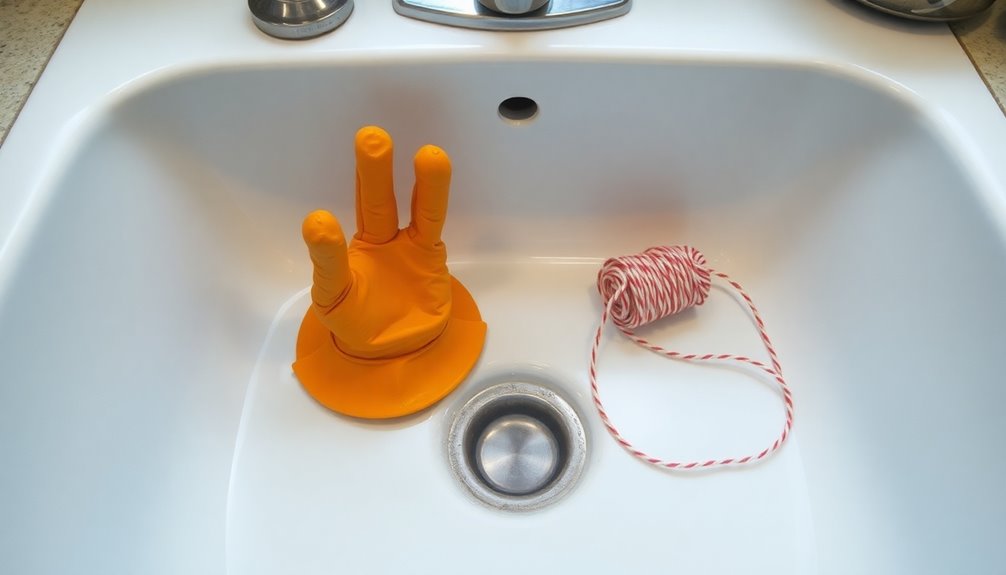
To keep your makeshift plug effective, regularly inspect it for any signs of wear or leaks.
After each use, make sure to clean it to prevent mold and odors from developing.
Finally, store it in a dry spot so it's easy to grab whenever you need it.
Regularly Inspect Condition
Regular inspections are essential for maintaining the effectiveness of your makeshift sink plug.
To guarantee it works properly, follow these steps:
- Check for Wear and Tear: Look for frayed edges or holes, as these can compromise the seal.
- Examine the Plastic Bag: Verify it remains intact and watertight to prevent leaks during use.
- Monitor the Washcloth or Sock: Replace them if they become overly saturated or lose their shape.
- Test the Seal: Fill the sink with water to confirm that your makeshift plug still creates a proper seal.
Store Properly After Use
After confirming your makeshift sink plug is in good condition, proper storage is key to maintaining its effectiveness. Rinse and dry it thoroughly to prevent mold and odors. Store it in a cool, dry place, away from direct sunlight to protect the materials. Placing the plug in a resealable plastic bag can shield it from dust and debris.
Here's a quick reference table for effective storage:
| Tip | Details |
|---|---|
| Rinse and Dry | Prevents mold and odors |
| Cool, Dry Place | Maintains material integrity |
| Resealable Bag | Keeps it clean and protected |
| Periodic Checks | Inspect for wear or damage |
| Designated Spot | guarantees easy accessibility |
With these steps, you'll keep your makeshift plug ready for use!
Clean After Each Use
Consistently cleaning your makeshift sink plug after each use is essential for maintaining its effectiveness.
Here are some tips to keep it in top shape:
- Remove the plug and rinse it thoroughly to eliminate any food particles or debris.
- Allow the plug to air dry completely before storing it to prevent mold or unpleasant odors.
- Regularly check for signs of wear and tear on the materials, replacing them if necessary.
- Clean the sink drain area with a mild detergent to prevent buildup that could affect performance.
Creative Solutions for Temporary Drain Stoppers
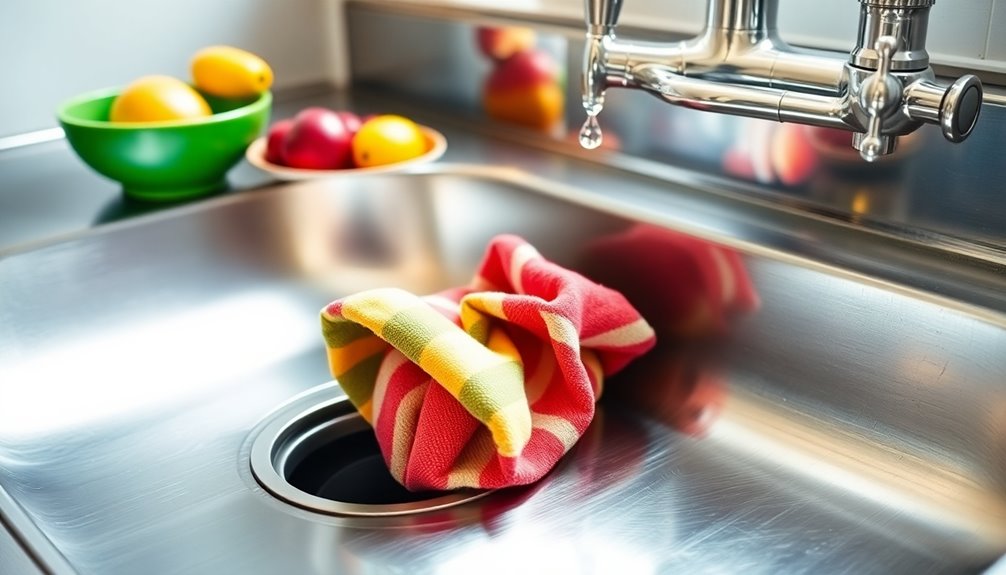
While you might not have a traditional sink stopper handy, there are plenty of creative solutions to temporarily block your kitchen sink drain. One effective method is to use a washcloth or sock wrapped in a plastic bag, securely knotted to fit snugly in the drain. Alternatively, a thin piece of plastic like a ziplock or grocery bag can be placed over the drain before adding an object to hold it down. Just make certain to test your makeshift plug to verify it can hold water for at least 20 minutes.
| Solution | Materials Needed | Effectiveness |
|---|---|---|
| Washcloth/Sock Plug | Washcloth or sock, plastic bag | Good for short tasks |
| Plastic Bag Cover | Ziplock or grocery bag | Quick and easy |
| Knotted Bag Plug | Plastic bag, knot | Reliable option |
User Experiences With DIY Sink Plugs
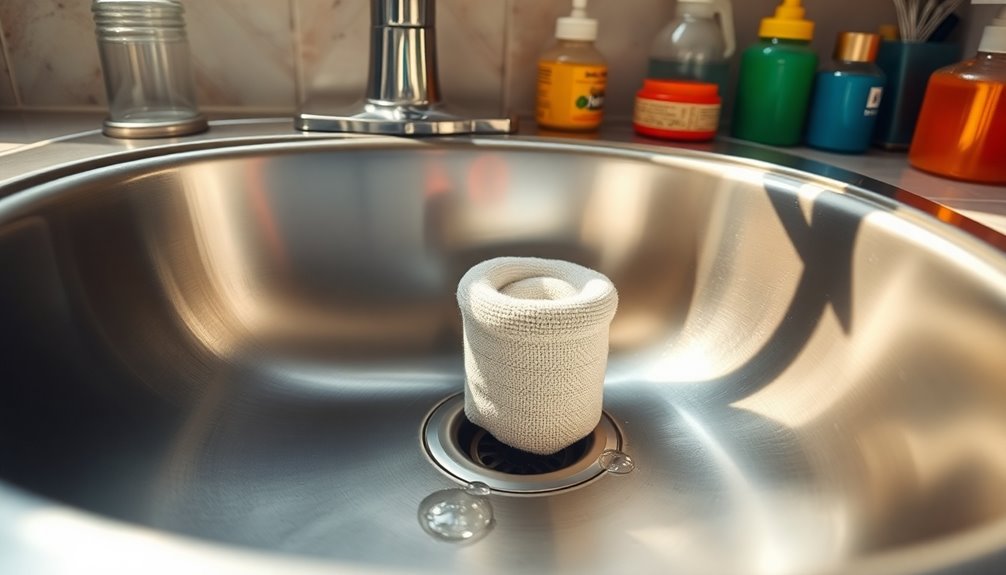
Many people have found innovative ways to tackle the problem of a missing sink stopper. You might appreciate how resourceful these solutions can be, especially in small spaces or while traveling.
Here are some popular DIY sink plug experiences:
- Old Socks or Washcloths: Many users wrap them in plastic bags for a quick fix.
- Yogurt Lid: This common item serves as a sturdy sink plug, adapting well to various sizes.
- Vacuum Method with a Plunger: Feedback indicates this technique effectively dislodges stubborn stoppers without causing damage.
- Nail Clippers: Some individuals have creatively used them to grip and pull out stuck stoppers, showcasing the versatility of everyday tools.
These solutions highlight the ingenuity many have embraced in everyday plumbing challenges.
Best Practices for Removing Stuck Sink Stoppers
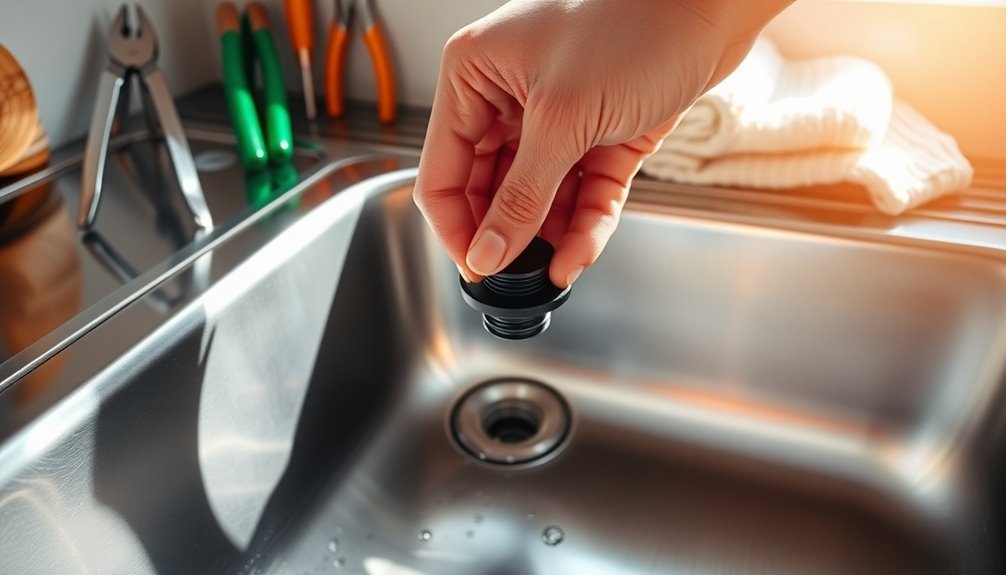
When you're faced with a stuck sink stopper, knowing the right techniques can save you time and frustration.
First, grab some pliers and grip the vertical wall of the stopper for better leverage. If that doesn't work, take a thin knife and gently pry along the edge of the stopper's rim, using the spine to avoid damage.
Another effective method is to fill the sink with water and use a toilet plunger to create a vacuum effect, which can help dislodge it. Nail clippers can also latch onto the rubber ridge for a secure grip.
If you're still struggling, apply super glue to a note card, attach it to the stopper, and use it as a makeshift handle for easier removal.
Frequently Asked Questions
What Can I Use Instead of a Sink Stopper?
If you're looking for alternatives to a sink stopper, you've got several options.
You can use a clean washcloth or an old sock wrapped in a plastic bag to block the drain effectively. A plastic lid from a yogurt container can also work if trimmed properly.
Alternatively, an inverted small bowl or cup can seal the drain until you find a proper stopper.
Get creative, and you'll find something that fits!
What Can I Use to Plug a Kitchen Sink?
To plug a kitchen sink, you've got several options.
You can use a washcloth or an old sock wrapped in a plastic bag for a tight seal. Alternatively, try placing a large plastic lid from a yogurt container over the drain after trimming it for a snug fit.
Thin plastic materials like grocery bags can also work well when combined with a stopper. Just make sure whatever you choose fits securely to prevent leaks!
How to Close a Drain Without a Stopper?
If you need to close a drain without a stopper, you can get creative with household items.
Try taking a washcloth or an old sock, wrapping it in a watertight plastic bag, and placing it over the drain.
Make sure the bag's sealed tight to prevent leaks.
You might need to experiment with different sizes until you find one that fits snugly, effectively blocking water from flowing through until you find a proper solution.
How Do You Unclog a Sink Without a Stopper?
To unclog your sink without a stopper, start by using a wet/dry vacuum to suction out the blockage, ensuring a tight seal around the drain.
Next, pour boiling water slowly to dissolve any grease buildup.
You can also try a baking soda and vinegar mixture, followed by hot water for a fizzy effect.
If those don't work, use a plumber's snake to physically remove the clog.
Finally, create pressure by filling another basin if you have a double basin sink.
Conclusion
To sum up, creating a makeshift sink plug can be a lifesaver when you need it most. With a little creativity and some common household items, you're just a few steps away from turning your kitchen sink into a temporary holding tank. Remember, with your DIY skills, you can conquer any plumbing challenge like a superhero wielding a plunger! So, don't let a missing stopper dampen your day—get crafty and keep that water in the sink where it belongs!
